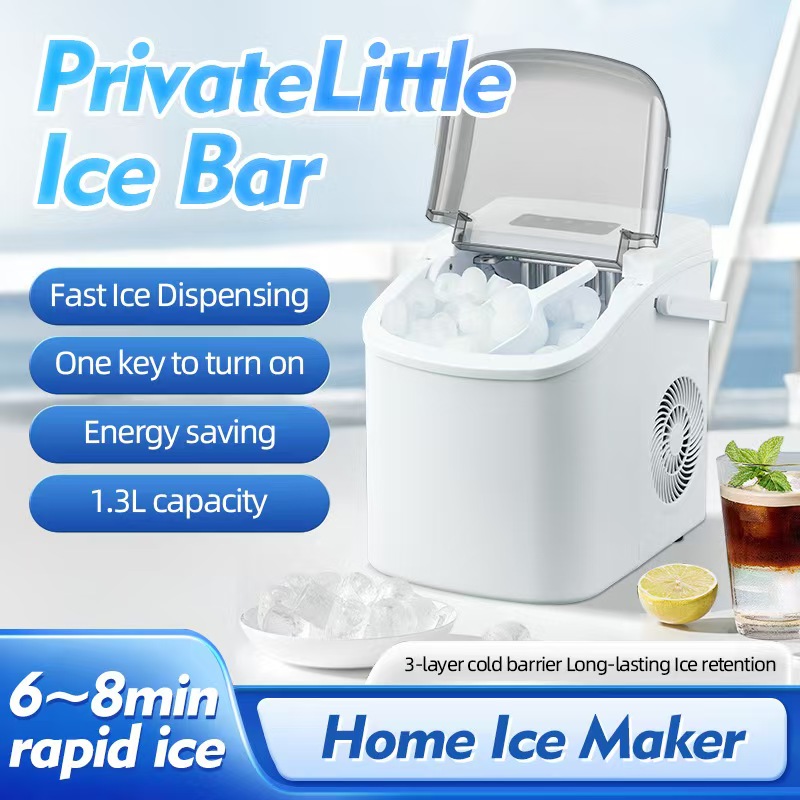The home ice maker market has been growing rapidly in recent years, especially in hot weather and high-temperature regions, where more and more households are purchasing ice makers. Below is an analysis of the home ice maker market:
1. Market Demand
·
Impact of Climate Change: With global warming and increasing extreme weather events, many people are choosing to buy ice makers to cope with the high temperatures of summer, especially in tropical and subtropical areas.
·
·
Lifestyle Changes: The popularity of home ice makers is closely related to modern consumers' pursuit of convenience in their daily lives. Many people want the convenience of having ice readily available at home, especially when hosting parties and gatherings.
·
·
Trend of Small Household Appliances: As consumer demand for home entertainment devices and small appliances rises, home ice makers have become an essential part of many households.
·
2. Market Drivers
·
Convenience and Speed: Home ice makers can quickly produce ice, meeting daily needs for drinks, especially during parties and barbecues.
·
·
Variety of Products: From small countertop ice makers to larger commercial-style machines, there is a wide range of products in the home market, catering to different consumer needs.
·
·
Decreasing Prices: With continuous advancements in technology and reductions in production costs, the prices of home ice makers have become more affordable, attracting more consumers.
·
·
Trends in Home Entertainment and Healthy Diet: Increased consumer interest in home entertainment and healthy eating has also driven the demand for ice makers and related products.
·
3. Market Challenges
·
Intense Market Competition: The home ice maker market has low entry barriers, and many brands and manufacturers have entered the market, leading to fierce price competition and minimal product differentiation.
·
·
Technical Limitations: While home ice makers are continuously improving, some products still face technical challenges related to ice production speed, ice quality, and noise control.
·
·
After-Sales Service Issues: Some consumers report that home ice makers are prone to malfunction, and the after-sales service from certain brands is inadequate, affecting consumers' purchasing decisions.
·
4. Market Trends
·
Smart Products: With the rise of smart homes, more and more home ice makers are equipped with smart features, allowing users to control and monitor the ice-making process remotely via smartphone apps.
·
·
Environmental and Energy Efficiency: Consumers are increasingly focused on eco-friendly and energy-efficient products, and the market has seen a rise in energy-saving ice makers that align with sustainable development trends.
·
·
Personalization and Customization: Some high-end brands have introduced more personalized and customized products, such as ice makers that produce ice in various sizes or shapes, catering to consumer preferences for unique ice cubes.
·
5. Regional Market Analysis
·
North America: The North American market is one of the key markets for home ice makers, particularly in the United States, where ice makers are widely used in homes, restaurants, and commercial establishments. There is a high demand for fast ice production and high-quality machines.
·
·
Asia: In countries like China, Japan, and South Korea, the demand for home ice makers is gradually increasing. With rising living standards, home ice makers are becoming more popular, particularly in major cities.
·
·
Europe: The demand for home ice makers in Europe is relatively stable, with higher demand concentrated in tropical and subtropical countries.
·
6. Major Brands
·
Snowflake: Snowflake has a significant market share in the home ice maker market, favored by consumers for its efficiency, quiet operation, and energy-saving features.
·
·
Midea: Midea holds a prominent position in the home ice maker market due to its brand reputation and high cost-performance ratio.
·
·
Mitsubishi Electric: Mitsubishi Electric’s ice makers typically target the high-end market, with a reputation for superior quality.
·
7. Future Outlook
The home ice maker market still has substantial growth potential in the coming years. With technological advancements and increasing consumer demand for convenient and eco-friendly products, ice makers will continue to integrate into modern household life. Particularly in the context of global climate change and the rise of smart homes, the demand for home ice makers is expected to continue to grow.
In conclusion, the home ice maker market has a bright future, but it also faces intense competition and certain technical challenges. Brands need to focus on product innovation, user experience, and after-sales service to gain a strong foothold in the market.




.png)




